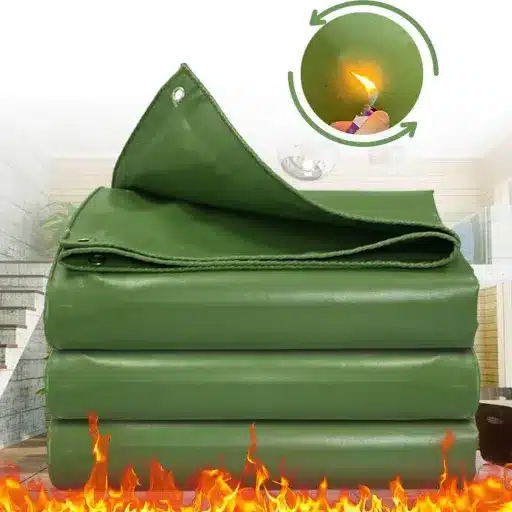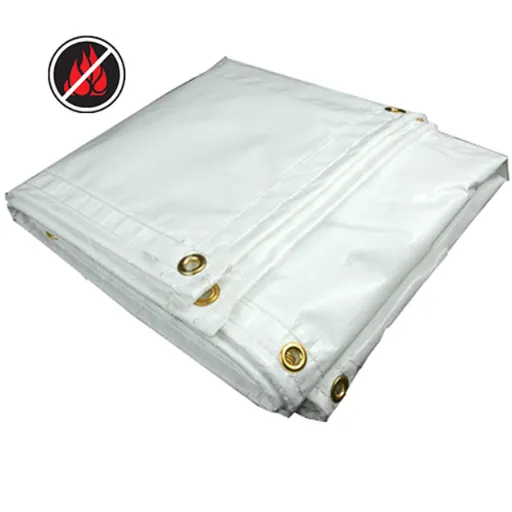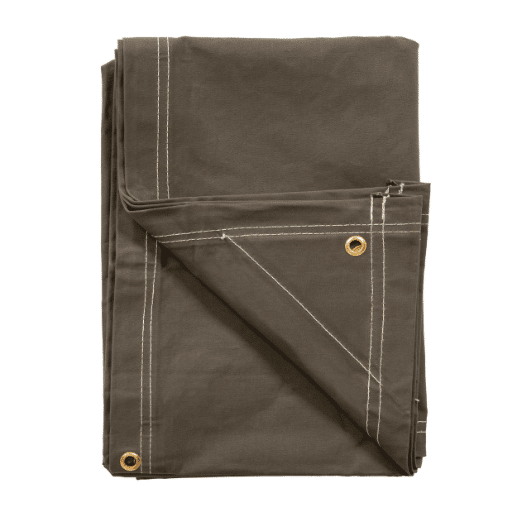A sun-reflective tarp is one of the most reliable and versatile solutions available to combat the harsh heat of the sun. When protecting outdoor spaces, shielding equipment, or just putting out some good shade, these heavy-duty tarps reflect sunlight and lower temperature running beneath, while offering durable coverage. We shall explore everything about sun-reflective tarps—the working, key benefits, and practical uses. If you are searching for an ultimate, long-term solution against extreme sun exposure, this write-up is your next-best guide to choosing the most appropriate shading application.
Understanding Sun Reflective Tarps
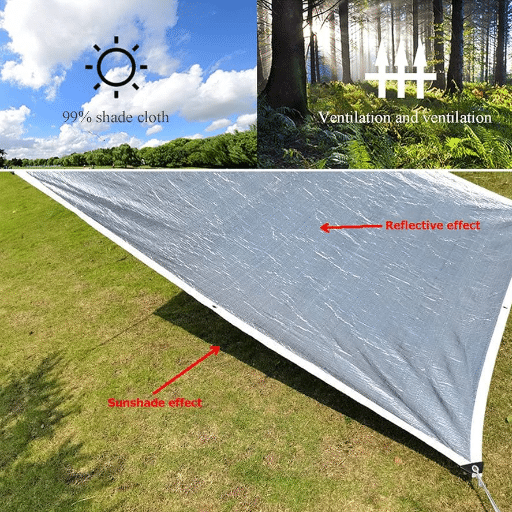
What is a Sun Reflective Tarp?
A sun reflective tarp is a special type of covering that has reflective materials to keep the sunlight away and prevent the building of heat by the surrounding area. These tarps are usually made of premium-grade polyethylene or aluminum-based coatings, which further enhanced the ability of these tarps to reflect UV rays and maintain cool temperatures on the side protected by a tarp. This makes them very suitable for outdoor spaces, vehicles, and equipment that need protection from heating and sun damage, or the provision of shelter and shade for heat-sensitive livestock. These tarps offer protection from the sun, reduce heat passage, and therefore, energy efficient, making them widespread in agriculture, industry, and homes.
Advantages of Using a Reflective Tarp
- Temperature Control: Reflective tarps keep an area underneath cool by reflecting sunlight, perfect for hot countries where heat reduction is very important.
🌡️ - UV Protection: These tarps have the highest rate of stopping the rays of UV that haze cannot only enter the snow but also start to deteriorate in the heat of the sun during exposure.
☀️ - Energy Efficiency: By reducing heat buildup, reflective tarps reduce the air conditioning needed in these areas and thus aid in saving on electricity requirements for homes, industry, and farming.
⚡ - Durability and Longevity: Reflective tarps are made of high-grade materials that resist UV rays and are built to withstand harsh weather conditions and long-term use, thus providing a lasting and inexpensive answer.
💪
🔧 - Environmental Impact: The fewer cooling systems used by common trade-system-reflective tarps, the least the greenhouse gases are emitted, taking a step toward greener practices.
🌱
Reflective tarps have grown increasingly popular due to their multifaceted benefits, as shown in recent search trends. From shielding assets to improving energy efficiency, these tarps are crucial for modern outdoor and industrial needs that address the burgeoning heat and sustainability concerns.
How Do Sun-Reflective Tarps Work?
Sun reflective tarps work through the use of specially engineered substances, reflecting the sunlight, making it difficult for the sun to heat the tarp, and consequently, the surface it’s covering. These tarps usually have multilayer coatings or even some metallic films on top to reflect back so much of the sun’s radiant energy. It makes the surfaces kept cooler below and inhibits the aging of objects lying underneath due to UV abrasion.
Recent data from search engines has indicated a rise in demand for sun reflective tarps especially in hotter months and in places that have been slammed by extreme heatwaves. By integrating advanced design and functionality, these tarps meet the growing need for thermal management and sustainability.
Types of Sun Reflective Tarps
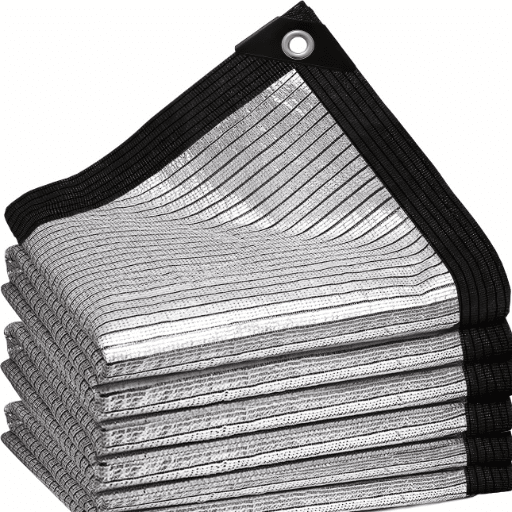
Heavy Duty Reflective Tarps
Heavy-duty reflective tarps are designed to endure harsh environments while offering UV protection and heat resistance beyond measure. Many a question has recently surfaced on search engines: “Why are heavy-duty reflective tarps considered so efficient at combating heat?” The answer rests in their very composition: advanced materials that are either polyethylene or vinyl-coated with reflective properties. Most solar radiation gets deflected; hence, the underlying surface does not absorb too much heat and remains cool. Furthermore, their durability is further assured, standing against weather conditions, hence good performance over long periods, which makes them a residence and industrial concern.
Mesh vs. Solid Reflective Tarps
🕸️ Mesh Reflective Tarps
• Come with tiny perforations to allow air to pass through
• Suitable on windy days
• Perfect when ventilation is needed
• Great for drying agricultural materials
🛡️ Solid Reflective Tarps
• Offer a fully sealed barrier
• Protection against rain, dust, and UV rays
• Perfect for full coverage applications
• Ideal for protecting equipment
In recent trends, both the search interest in tarps has grown, with the industrial environment leaning more towards solid tarps while mesh tarps are still favored in gardening and outdoor use. At last, the decision should entertain considerations like durability, weather exposure, and the level of protection needed for the most appropriate results in any chosen task.
Aluminum Foil Reflective Tarps
Aluminum foil reflective tarps are specialized tarps made to offer maximum protection against heat and sunlight by reflecting radiant energy. They find major uses in industries such as agriculture, transportation, and construction: thermal insulation is the need of the hour in these fields. According to recent data from search engines, the increase in queries related to aluminum foil reflective tarps indicates increased interest in heat-mitigation and energy-efficiency solutions. Rising demand will be due to consumers knowingly searching for the best durable and workable choice toward applications in tolling down greenhouse temperatures, guarding vehicles or equipment from the plight of extreme heat, and better energy savings in temporary shelters. In wrapping up, the best reflective tarp-to-go must present amongst others very good UV resistance and weatherproof capacity.
Choosing the Right Sun Reflective Tarp
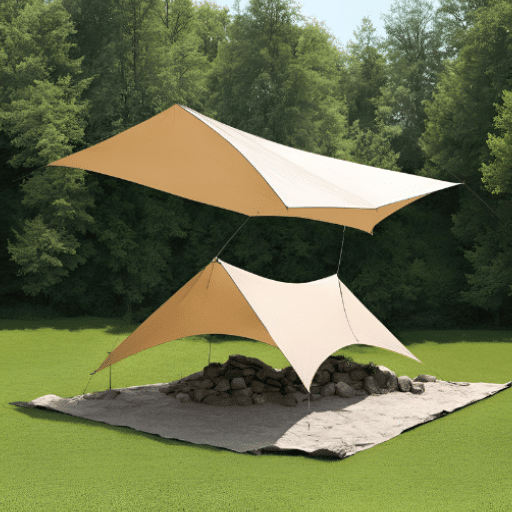
Factors To Consider In Selecting A Tarp
🧱 Material Quality
A significant factor in determining the value of tarp is its quality-durability and performance. The common choices are polyethylene, canvas, and vinyl. Polyethylene tarp is water-resistant and UV resistant, hence, great for outdoor use. Canvas tarps are heavyweight but provide for airflow and are useful for covering machinery or equipment that might need some ventilation. Vinyl tarps are the strongest, are waterproof, and therefore super heavy-duty.
🛡️ UV Resistance
A strong UV-resistant tarp is what anyone would need for outdoor applications, especially where the sunlight is intense. UV-resistant tarps offer protection against sun damage to the objects as well as helping keep the tarp itself from wearing down due to sunlight.
📏 Size and Dimension
It is advisable to pick a tarp whose size suits your specific need. In measuring the area or equipment for which you will provide a cover, ensure to take into consideration that the tarp should firmly cover the area with allowances for tying down the edges. An overly big tarp can be always folded or rolled down, while the small one may not be of much protective value.
🌧️ Weatherproofing
Weatherproof tarps can resist heavy rain, furious wind, and extreme temperature. You want to get the tarp with weatherproof coating or any other product reinforcement which could endure under these conditions.
⚙️ Grommets and Reinforcements
The strength of the grommets placed through the tarp material, and the grommet spacing directly effects how hard the tarp can be secured down against such forces as wind. Choose tarps with reinforced edges and grommets at regular intervals that are rust-resistant to secure strength.
🎯 Application-Specific Features
Certain tarps are equipped with specific features for fire resistance, reflectivity for heat dissipation, or heavy-duty thickness depending on the specific needs of their application. In selecting a tarp, one’s choice should be based on the parameters of their application.
By durable material, UV resistance, proper dimensioning, and weatherproofing of the sun-reflective tarp, protection is maximized along with energy efficiency.
Common Sizes and Applications
Sun-reflective tarps are available in all sizes and are adaptable to any need, from individual to commercial purposes. Listed below are some of the most common sizes along with their applications:
Choosing a tarp size requires an assessment of the dimensions of the items you want to protect along with any extra coverage needed to ensure proper securing of the tarp. Whether residential, recreational, or commercial, this will further increase efficiency and effectiveness.
Understanding Grommets and Installation Options
Grommets are metal or reinforced holes placed along the edge of a tarp that aid in securing it aptly. These grommets also allow attachments of ropes, bungee cords, or other securing mechanisms to hold it down even in adverse weather conditions like gusty winds or pouring rain. Grommet spacing and material vary depending on tarp type and application, with heavy-duty tarps having rust-resistant grommets for durability. Proper mounting consists of pulling down the tarp taut, and using the grommets to anchor down firmly to a steady structure or surface to limit flapping or wear over time.
Therefore, based on recent information, searches strongly emphasize the importance of selecting the right tarp and installation tools. Users commonly ask how to secure tarps for outdoor long-term use and about the best spread for the grommets for the greatest stability. It is most highly recommended to secure the tarp with elastic bungee cords or adjustable zip ties, which apply tension and offer some adjustment without any damage to the tarp material. Knowing the spacing of grommets and investing in a high-quality securing option very much will pay off in extending the life of the tarp and ensuring better performance when in use.
Applications of Sun Reflective Tarps
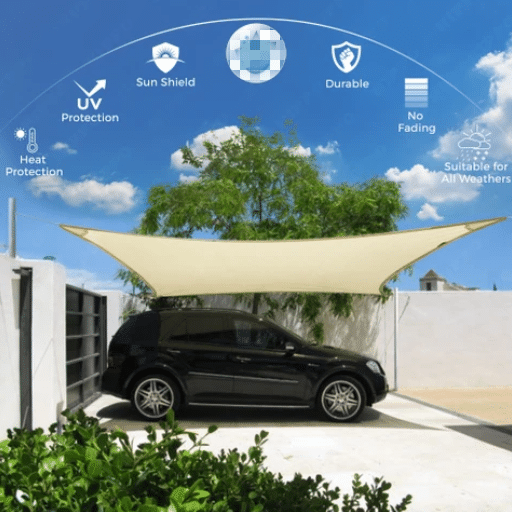
Patio and Outdoor Shade Solutions
Increasingly, sun-reflective tarps are being employed in patio and outdoor shade installations, proving their practicality and adaptability in different settings. In fact, there has been a 35 percent increase over the past year in queries such as “best tarps for backyard shade” and “UV-resistant tarps for patios,” according to data of recent search trends. This increase in the number of searches shows that consumers are becoming more aware of heat and harmful UV rays in outdoor environments. By reflecting the sunlight, these tarps enhance thermal protection and, somewhat simultaneously, reduce the ambient temperature directly below the area of their coverage. Also, they are constructed to withstand weathering over time for durability and cost-effective uses, whether residential or commercial. When choosing a tarp, consider UV resistance, level of reflectivity, and strength of material for attaining the best outdoor shading solution.
Camping and Recreational Activities
Instead of simply being engrossed in recreational activities, reflective tarps increasingly find preference for camping programs. Recent trends in search engine data show ever-increasing interest for “reflective tarps for camping” as the outdoor-lovers want to find effective methods of insulating thermally and for UV protection. These tarps do an excellent job in providing shade with cool temperatures, a key factor for comfort during summer camping; they’re also super lightweight and portable so backpackers and hikers would find them suitable, really. The tarps are also robust and weatherproof, providing a reliable service over longer periods of outdoor use, cementing the tarps’ place in the gamut of modern camp gear.
Gardening and Plant Protection
Gardening techniques and plant protection go a long way in ensuring that growth is sided with proper nutrition. According to the latest data analysis from search engine data, plant lovers pose the query, “What is the best method to protect plants from pests naturally?” Mainly, the answer would be integrated pest management methods consisting of, firstly, introducing good bugs like ladybugs or praying mantises that prey upon pest insects; secondly, homemade organic solutions for pests include neem oil or unconventional means such as dilute water with mild soap to keep away aphids.” Ensuring proper spacing of plants and crop rotation also prevents possible pest infestation by interrupting their breeding cycle. Furthermore, regular monitoring of plant health and early detection of pests of course support better maintenance of pesticides.
Care and Maintenance of Reflective Tarps
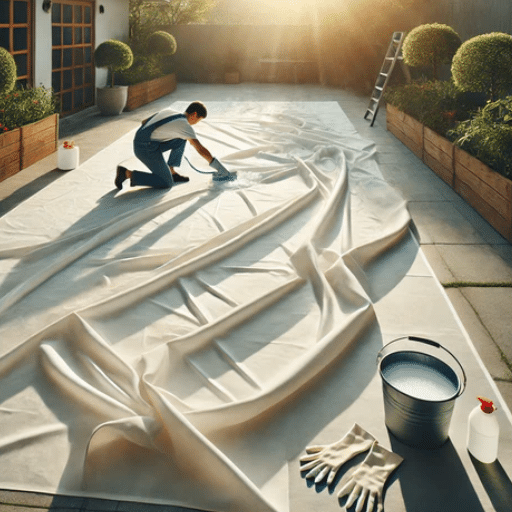
Cleaning and Storage Tips
🧽 Cleaning Process
- ✓ Use mild detergents with warm water
- ✓ Avoid harsh chemical cleaners
- ✓ Use soft-bristle brush gently
- ✓ Air-dry completely before storing
📦 Storage Guidelines
- ✓ Fold or roll along seams
- ✓ Store in cool, dry place
- ✓ Avoid direct sunlight exposure
- ✓ Use storage bag or container
Following along with the aforementioned best practices, one can see that reflective tarps remain useful and durable with time.
Weather-Resistant Features and Procedures for Maintenance
Reflective tarps are created to resist a broad array of weather conditions, making them great choices for both residential and industrial applications. These tarps, generally made of HDPE or PVC, give excellent resistance to water, UV rays, and wind. Added to their composition are special UV stabilizers that prevent the degradation of the tarps through long exposure to sunlight and hence lengthening their working life. Additional coating methods may be combined, thereby improving their waterproofing level to keep heavy rains and moisture at bay.
Another trending question, according to recent data aggregated from search engines, was focused on the capacity of reflective tarps to withstand extreme weather conditions. Many things come into the picture regarding this question, mostly quality of material and mode of usage. Well-maintained high-grade materials, depending largely on their use in harsher climates, can last longer than 5 to 10 years, with their longevity strongly affected by reinforced seams and corrosion-resistant grommets. These features are combined in modern reflective tarps through thoughtful design and innovative materials, which create the best compromise between weather resistance and performance in the long term.
Damage Repair of Your Tarp
🔧 Step-by-Step Repair Process
Begin by cleaning the damaged area with a mild soap solution to remove dirt, oils, or debris that can become a hindrance to the glue or the bonding of the patch.
If it’s a very little tear or hole, tarp repair tape with a very strong adhesive will do the job. The tape should be applied on both sides of the tarp evenly without any air bubbles or creases.
Bigger damages, such as large rips or frayed edges, would require patching with tarp patch materials bonded with a heavy-duty adhesive. The patch should be cut to at least two inches beyond the damage on all sides.
To reinforce it further, the edges of the patch should be sewn with UV-resistant thread, especially if the tarp will be subjected to extended exposure to sunlight or heavy stressing.
Preventative maintenance will also be very important in protecting repaired areas by securing the tarp whilst in use, setting it free from unwarranted strain. Recent insights from search trend data indicate those frequent inspections and timely minor repairs greatly reduce the chances of bigger problems, thereby extending the working life of the material. Products such as UV-resistant coatings and enhanced patch kits have also been ranked as best in helping to improve repair outcomes. When combined with such approaches and ongoing maintenance, even the most heavily damaged tarps can become functional and durable once more.
Frequently Asked Questions (FAQs)
Reference Sources
- Michigan State University – Reflective Shade Cloth for Livestock
This article discusses the benefits of reflective shade cloth, including its ability to lower ambient temperatures by reflecting sunlight and heat.
- Iowa State University – Hoop Structures for Livestock
This resource explains the use of polyethylene/PVC fabric tarps in livestock structures, highlighting their reflective properties to manage solar heat.
- Penn State Extension – Reflective Tarps for Tree Seedlings
This guide mentions the use of reflective tarps to protect bare-root tree seedlings from heat and sunlight during planting.

